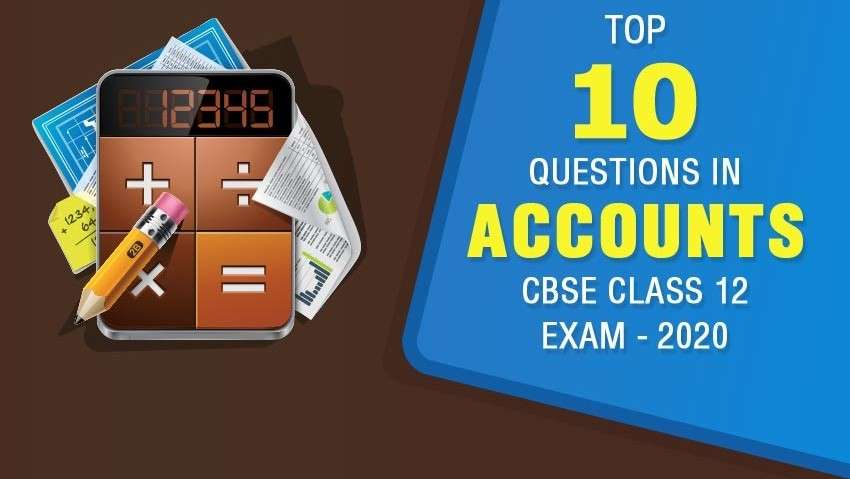Top 10 Questions in Accounts CBSE Class 12 Exam - 2020

Check top 10 important accounts questions and answers that will help you plan your study and revision in CBSE Class 12 Accounts exam - 2020
By Topperlearning Expert 27th Feb, 2020 | 06:52 pm
ShareYour Accountancy board paper for 2020 will comprise two sections, where Part A is compulsory for all and Part B has 2 options.
Part A is for 60 marks which comprises Accounting for Not-for-Profit Organisations, Partnership Firms and Companies. Part B is for 20 marks which has 2 options—Analysis of Financial Statements and Computerised Accounting.
Here are some important questions that you should not miss while studying for your Accountancy paper.
Part A: Accounting for Not-for-Profit Organisations, Partnership Firms and Companies [60 Marks]: Following is the list of questions which you can expect in Part A of your Accountancy paper:
-
Financial Statements of Not-for-Profit Organisations
1. Prepare the income & expenditure account and balance sheet for the year ending 31.03.2019 from the receipts & payments account given below.
|
Receipts |
Amount |
Payments |
Amount |
|
To Balance b/d Cash at Bank 1,22,500 To Subscription To Bank Interest To Sale of Van |
1,35,000 2,00,000 1,000 20,000
|
By Rent By Printing & Stationery By Salaries By Printer By Investments By Balance c/d: Cash in hand 6,500 Cash at Bank 1,00,000
|
30,000 9,500 1,50,000 20,000 40,000
1,06,500 |
|
|
3,56,000 |
|
3,56,000 |
Additional Information:
- Subscriptions include Rs. 40,000 for the year ending 31.03.2018 & Rs. 20,000 for the year ending 31.03.2020. Rs. 40,000 of the current year are still in arrears.
- Investments were purchased on 01.10.2018 and earns an interest @5% p.a.
- Rent for 1 month Rs. 2,500 is still outstanding.
- Payment for stationery Rs. 1,500 is still outstanding.
- Van sold for Rs. 20,000 had a book value of Rs. 27,500.
[6 M] [Modified question asked in 2019]
Suggested Answer:
Dr. Income and Expenditure Account Cr.
for the year ended 31st March 2019
|
Expenditure |
Amount |
Income |
Amount |
|
|
To Rent 30,000 |
|
By Subscription 2,00,000 |
|
|
|
Add: Outstanding 2,500 |
32,500 |
Less: For 2017-18 (40,000) |
|
|
|
To Printing and Stationery 9,500 |
|
For 2019-20 (20,000) |
|
|
|
Add: Outstanding 1,500 |
11,000 |
1,40,000 |
|
|
|
To Salaries |
1,50,000 |
Add: Outstanding 40,000 |
1,80,000 |
|
|
To Loss on Sale of Van |
7,500 |
By Bank Interest 1,000 |
|
|
|
|
|
Add: Accrued 1,000 |
2,000 |
|
|
|
|
By Deficit |
19,000 |
|
|
|
2,01,000 |
|
2,01,000 |
|
Balance Sheet as on 31st March 2019
|
Liabilities |
Amount |
Amount |
Assets |
Amount |
|
Capital Fund: Opening Balance Less: Deficit Advance Subscription Outstanding Rent Outstanding Printing & Stationery |
2,02,500 (19,000) |
1,83,500 20,000 2,500 1,500 |
Cash in hand Cash at bank Outstanding Subscription Interest Accrued Investments Printer |
6,500 1,00,000 40,000 1,000 40,000 20,000 |
|
|
|
2,07,500 |
|
2,07,500 |
Working Notes:
Calculation of Opening Balance of Capital Fund:
Balance Sheet as on 31st March 2018
|
Liabilities |
Amount |
Assets |
Amount |
|
Capital Fund |
2,02,500 |
Cash in hand Cash at bank Outstanding Subscription Van |
12,500 1,22,500 40,000 27,500 |
|
|
2,02,500 |
|
2,02,500 |
-
Accounting for Partnership Firms
2. M, S and U are partners in a firm sharing profits in the ratio 3:1:1 with fixed capital balances of Rs. 2,00,000, Rs. 80,000 and Rs. 60, 000, respectively. The net profit for the year ending 31st March 2019 distributed among the partners was Rs. 50,000 without providing for the following adjustments:
- Salary of Rs. 9,000 was paid to M and was also allowed a commission of 6% divisible profit after charging such commission.
- Commission paid to U was Rs. 6,000.
- Interest on capitals @2.5% p.a.
Pass the rectifying entry by showing all the workings clearly.
[6 M] [Modified question asked in 2015, 2017, Sample Paper 2018-19, 2019]
3. M, N and O are partners sharing profits and losses in the ratio 5:3:2. On 1st April 2018, they decided to change their profit-sharing ratio so that they share all future profits and losses equally. On this date, goodwill appeared in their books at Rs. 24,000 which was revalued at Rs. 60,000.
Pass the necessary journal entries assuming that goodwill will not appear in the books of account.
[4 M]
4. Vini and Mani are partners in a firm sharing profits in the ratio 3:2. The balance sheet on 1st April 2018 was as follows:
|
Liabilities |
|
Amount |
Assets |
|
Amount |
|
Capital A/c: |
|
|
Plant |
|
30,000 |
|
Vini |
30,000 |
|
Patents |
|
10,000 |
|
Mani |
25,000 |
55,000 |
Stock |
|
20,000 |
|
General Reserve |
|
10,000 |
Debtors |
|
18,000 |
|
Creditors |
|
15,000 |
Cash |
|
2,000 |
|
|
|
|
|
|
|
|
|
|
80,000 |
|
|
80,000 |
On the above date, Jai is admitted as a partner on the following terms:
- The incoming partner was to introduce Rs. 20,000 as capital, and the capital of the remaining partners was to be adjusted in the new profit-sharing ratio by bringing in the required amount of cash or paying off the surplus as the case may be.
- It was decided that the incoming partner will pay Rs. 10,000 as premium for 1/4th share in the future profits.
- In the event of admission, assets are to be valued as follows:
- Plant Rs. 32,000
- Stock Rs. 18,000
- Debtors at book value less a provision for doubtful debts of 5%.
- Creditors of Rs. 1,400 was not to be paid. It was also found that there was a liability for compensation to workers amounting to Rs. 2,000.
Prepare Revaluation A/c, Partners’ Capital A/c and Balance Sheet in the event of admission of the new partner Jai.
[8 M] [Modified question asked in 2017, 2018, Sample Paper 2018-19, 2019]
5. S, H and R were partners in a firm and the Balance Sheet of the firm as on 31st March 2014 is as follows:
|
Liabilities |
Amount |
Assets |
Amount |
|
Capital A/cs: S 15,000 H 15,000 R 10,000 General Reserve Sundry Creditors |
40,000 15,000 5,000 |
Plant & Machinery Furniture Investments Stock Sundry Debtors |
20,000 7,500 10,000 12,500 10,000 |
|
|
60,000 |
|
60,000 |
On 31st December 2014, H died, and as per the partnership deed, the representatives of the deceased partner are entitled to
- Capital Account Balance of the deceased partner
- Share in the undistributed profits or losses as per the Balance Sheet
- Share in the profits of the firm till the date of his death calculated on the basis of the rate of net profit on the sales of the previous year (which was 20%); sales for the year till 31st December 2014 was Rs. 3,00,000
- Interest on capital @6% p.a. up to the date of his death
Prepare H’s Capital Account to be presented to his executors.
[6 M] [Modified question asked in 2013, 2014, 2015, 2017, 2018, 2019]
-
Accounting for Companies:
6. Begam Ltd. issued 25,000 shares of Rs. 10 each at a premium of Rs. 2 per share payable as follows:
On Application - Rs. 3 per share
On Allotment - Rs. 4 per share (including premium)
On First Call - Rs. 2 per share
On Final Call - Balance
Applications were received for 37,500 shares and pro-rata allotment was made to all the applicants. All the money due was received except allotment and first call from Neha who applied for 600 shares. All her shares were forfeited which were then reissued for Rs. 4,800.
Assuming that the final call was not made, pass the necessary journal entries.
[8 M] [Modified question asked in 2015, 2018, 2019]
7. Mahesh Limited issued Rs. 15,20,000, 9% debentures of Rs. 100 each on 1st April 2013 which are redeemable at a premium of 5% on 30th June 2015. The company transferred an amount of Rs. 3,80,000 to Debenture Redemption Reserve on 31st March 2015. Also, investments as required by law were made in the fixed deposit of a bank on 1st April 2015.
Pass the necessary journal entries for redemption from 31st March 2015 ignoring the interest on the fixed deposit.
[6 M] [Modified question asked in 2016, 2018, 2019]
Part B: Analysis of Financial Statements [40 Marks]: Following is the list of questions which you can expect in Part B of your Accountancy paper:
-
Analysis of Financial Statements:
8. From the information given below, prepare a comparative income statement for the company:
|
Particulars |
Note No. |
31st March 2019 |
31st March 2018 |
|
Revenue from Operations Other Income (% of Revenue from Operations) Expenses (% of Operating Revenue) Tax Rate |
|
45,00,000 20% 70% 30% |
32,00,000 25% 60% 30% |
[4 M] [Modified question asked in 2014, 2016, 2019]
Suggested Answer:
Comparative Income Statement for the years ended 31st March 2018 and 2019
|
Particulars |
Note No. |
31st March 2018 |
31st March 2019 |
Absolute Change |
Percentage Change |
|
|
|
(A) |
(B) |
(C = B - A) |
(D = C/A x 100) |
|
I. Revenue from Operations II. Other Income (WN) |
|
32,00,000 8,00,000 |
45,00,000 9,00,000 |
13,00,000 1,00,000 |
40.63 12.5 |
|
III. Total Revenue (I+II) IV. Expenses (WN) |
|
40,00,000 19,20,000 |
54,00,000 31,50,000 |
14,00,000 12,30,000 |
35 64.06 |
|
V. Profit before Tax (III-IV) VI. Less: Tax (30%) |
|
20,80,000 6,24,000 |
22,50,000 6,75,000 |
1,70,000 51,000 |
8.17 8.17 |
|
VII. Profit after Tax (V-VI) |
|
14,56,000 |
15,75,000 |
1,19,000 |
8.17 |
Working Notes:
|
Particulars |
31st March 2018 |
31st March 2019 |
|
Other Income |
25% x 32,00,000 = 8,00,000 |
20% x 45,00,000 = 9,00,000 |
|
Expenses |
60% x 32,00,000 = 19,20,000 |
70% x 45,00,000 = 31,50,000 |
9. Compute gross profit ratio from the information given below:
Average Inventory = 3,50,000
Inventory Turnover Ratio = 6 times
Average Trade Receivables = 4,00,000
Trade Receivables Turnover Ratio = 5 times
Cash Sales = 20% of Net Sales
[3 M] [Modified question asked in 2016, 2018, 2019]
-
Cash Flow Statement:
10. Following is the balance sheet of R Ltd. along with the additional information as on 31.3.2018. You are required to prepare a cash flow statement from the given information:
|
Balance Sheet of R Ltd. as on 31-3-2018 |
|||||||
|
Particulars |
Note No. |
31-03-2018 Rs. |
31-03-2017 Rs. |
||||
|
|
I. Equity and Liabilities |
|
|
|
|||
|
|
1. Shareholders’ Funds |
|
|
|
|||
|
|
(a) Share Capital |
|
1,80,000 |
1,40,000 |
|||
|
|
(b) Reserve and Surplus |
1 |
50,000 |
20,000 |
|||
|
|
2. Non-Current Liabilities |
|
|
|
|||
|
|
(a) Long-term borrowings |
2 |
90,000 |
70,000 |
|||
|
|
3. Current Liabilities |
|
|
|
|||
|
|
(a) Short-term borrowings |
3 |
30,000 |
15,000 |
|||
|
|
(b) Short-term provisions |
4 |
40,000 |
25,000 |
|||
|
Total |
|
3,90,000 |
2,70,000 |
||||
|
|
|
|
|
||||
|
|
II. Assets |
|
|
|
|||
|
|
1. Non-Current Assets |
|
|
|
|||
|
|
(a) Fixed Assets |
|
|
|
|||
|
|
Tangible Assets |
5 |
2,93,000 |
1,81,000 |
|||
|
|
Intangible |
6 |
20,000 |
30,000 |
|||
|
|
(b) Non-Current Investments |
|
30,000 |
20,000 |
|||
|
|
2. Current Assets |
|
|
|
|||
|
|
(a) Current Investments |
|
8,000 |
14,000 |
|||
|
|
(b) Inventories |
7 |
24,400 |
14,400 |
|||
|
|
(c) Cash and Cash Equivalents |
|
14,600 |
10,600 |
|||
|
|
|
|
|
||||
|
Total |
|
3,90,000 |
2,70,000 |
||||
Notes to Accounts:
|
Note No. |
Particulars |
31-3-2018 Rs. |
31-3-2017 Rs. |
|
1. |
Reserve and surplus |
|
|
|
|
(Surplus, i.e. Balance in the Statement of Profit & Loss) |
50,000 |
20,000 |
|
|
|
50,000 |
20,000 |
|
|
|
|
|
|
2. |
Long-term borrowings |
|
|
|
|
12% Debentures |
90,000 |
70,000 |
|
|
|
90,000 |
70,000 |
|
|
|
|
|
|
3. |
Short-term borrowings |
|
|
|
|
Bank overdraft |
30,000 |
15,000 |
|
|
|
75,000 |
15,000 |
|
|
|
|
|
|
4. |
Short-term provisions |
|
|
|
|
Provisions for tax |
40,000 |
25,000 |
|
|
|
40,000 |
25,000 |
|
|
|
|
|
|
5. |
Tangible Assets |
|
|
|
|
Machinery |
3,35,000 |
2,09,000 |
|
|
Accumulated depreciation |
(42,000) |
(28,000) |
|
|
|
2,93,000 |
1,81,000 |
|
|
|
|
|
|
6. |
Intangible Assets |
|
|
|
|
Goodwill |
20,000 |
30,000 |
|
|
|
20,000 |
30,000 |
|
|
|
|
|
|
7. |
Inventories |
|
|
|
|
Stock in trade |
24,400 |
14,400 |
|
|
|
24,400 |
14,400 |
|
|
|
|
|
Additional Information:
- Rs. 20,000, 12% debentures were issued on 31.3.2018.
- During the year, a part of machinery costing Rs. 16, 000 with accumulated depreciation of Rs. 8,000 was sold at a loss of Rs. 2,000.
[6 M] [Modified question asked in 2017, 2019]
Watch the video on how to score more than 90% in CBSE Class 12 Accounts Exam - 2020
For reviewing all the important answers and practice material for CBSE Class 12 Accounts exam 2020 click here:
CBSE Class 12 Accounts exam 2020 - Sample Papers
CBSE Class 12 Accounts exam 2020 - Previous years papers
You may also get expert advice from subject matter experts and get your doubts cleared in 24 hours at Ask the expert or call our counsellor on 1800-212-7858.
More from Education
Important Resources
- Education Franchisee opportunity
- NCERT Solution
- CBSE Class 9 Mathematics
- NCERT Solutions for class 10 Science
- Sample Papers
- CBSE Class 9 Science
- NCERT Solutions for class 10 Maths
- Revision Notes
- CBSE Class 10 Hindi
- CBSE Class 10 English
- CBSE Class 10 English
- CBSE Class 10 Social Studies
- CBSE Class 10 Science
- CBSE Class 10 Mathematics
- Career In Science After 10
- Career In Commerce After 10
- Career In Humanities/Arts After 10
- NCERT Solutions for Class 10
- NCERT Solutions for Class 11
- Business Studies Class 12 CBSE project





